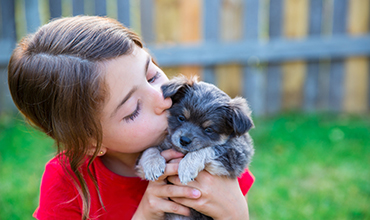There is something divine about a good dog. Simple, trustworthy and loyal to the core, it reflects back to us that which makes us our best selves. In its eyes, we do no wrong and we are always worthy of an effusive greeting, whether we’ve been gone five minutes or five days.
As a child, I counted my dog as one of my best friends. Her humble devotion meant that she was the perfect spot to lay my head after a hard or trying day. When I had to go downstairs in the night to get a drink of water, her steady presence meant there was no fear. And, with the patience of Job, when no one was free to play, she became my playmate – getting dressed up in my t-shirt or having her fur styled with barrettes. She was the best.
When I grew up and had three small humans of my own, I knew that I wanted them to have the same sort of heart-shaping experiences as I did. I wanted them to learn to care for and respect an animal, to feel the responsibility and privilege of receiving a dog’s love, and to have a place to lay their heads after a long day.
To my great joy, with research and a little luck, Murphy has been just that for my kids. He is counted as one of their best friends. He recently withstood the indignity of being dressed up for Halloween. He has had many a small and troubled head laid against the curve of his back.
What a Pet Can Teach a Child
During the holidays, many parents consider gifting their children with a dog. It is a gift that offers companionship, along with so much more:
- Responsibility and caretaking. Dogs need walking, bathing, feeding and regular bathroom breaks. Involving your child in your dog’s care will help her to develop a sense of responsibility.
- Perseverance and patience. It will take a while for any dog to settle into your home and to learn your family’s rules, especially if you bring home a puppy. Involving your child in the dog’s training will help him to practice perseverance and patience as the animal learns what is expected.
- Gentleness and respect. Dogs should always be treated with kindness and respect. Making that a non-negotiable rule will help your child learn how to be thoughtful and gentle with animals, which can carry over to friends and to others.
- Empathy. Dogs can’t easily communicate their needs, so we have to learn to attune to their signals and moods. Learning to do so will help your child gain perspective and empathy for another’s needs and feelings.
- Life lessons. It is a hard fact that dogs do not live as long as humans and that losing a pet is heartbreaking. Yet, there is much to be learned through the grieving process. It can teach kids how to cope with other losses that they will inevitably encounter in life.
Deciding on the Right Dog
When choosing a dog, it is important to consider the following things so that you find the best fit for both your family and your new pup:
- Don’t rush. It can be tempting to hurry and pick a dog in time for the holidays, but the dog will be with you for its lifetime. Instead, you can gift dog supplies like a bed, leash or toys for your kids to unwrap and then let them share in the excitement of researching and picking the right dog for your family.
- Activity level. This counts for both the dog and for your family. For example, our family is always on the go, so we needed a lower energy dog, one that wouldn’t need regular walks or frequent stick throwing to keep him happy.
- Size. Smaller dogs can be satisfied with smaller homes or yards, but larger dogs will need more space.
- Temperament. Do you need a dog that is easygoing with children or are you looking for a more driven dog that will participate in agility training? Carefully consider whether or not a dog’s temperament is a good fit for your family.
- Timing. Are you prepared to bring a dog home? Do you have space and time in your schedule to care for and to train the dog? Do you have upcoming travel that may interfere with consistency? Our family elected to wait until after Christmas to bring our dog home so that we could put away ornaments and other Christmas decorations that could have been unsafe should our puppy get hold of them. Consider timing when you decide to get a dog.
- Training and socialization. It is imperative that you train and participate in socialization activities with your pup. These actions will ensure that your dog is manageable, enjoyable, and most importantly, safe around children and other animals.
American writer Caroline Knapp said it well: “Before you get a dog, you can’t quite imagine what living with one might be like; afterward, you can’t imagine living any other way.” With thoughtful consideration and careful selection, your child, too, can know the joy and deep companionship of sharing life with a dog.
Alison Bogle is a writer living in Austin with her husband and three children. A former fourth-grade teacher, she now enjoys writing about children and education.


















